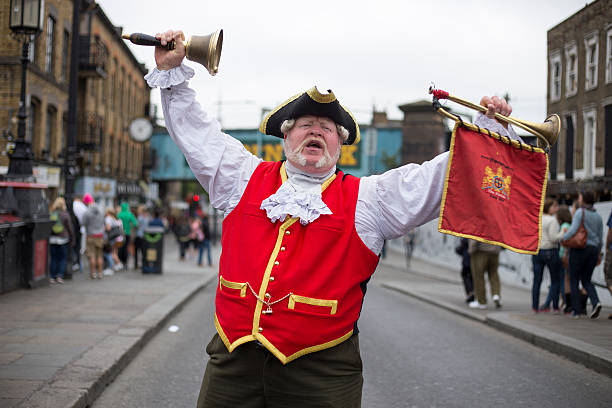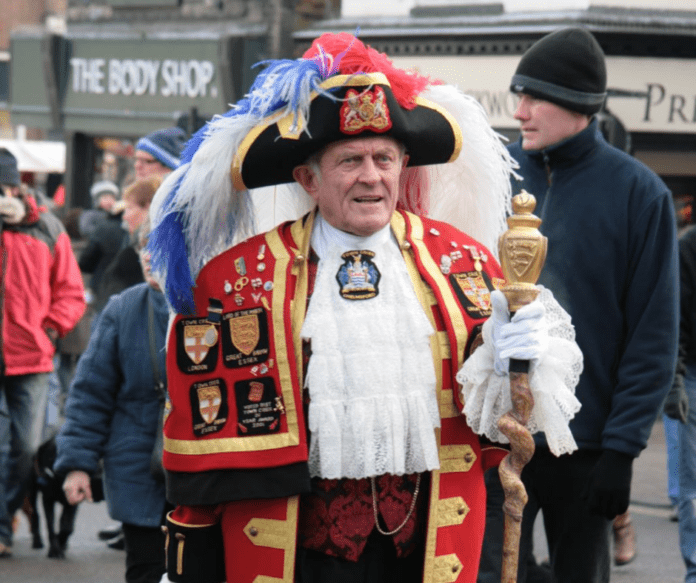A Brief History of Criers!
You may have wondered about our Stratford Town Crier, pictured here. The formal role of town crier dates back to Medieval times, but our little guy is only a few years old, and was created by my son, artist Kieron Dwyer.

“Oyez, oyez, oyez!” (Pronounced ‘oh yay’ and taken from the French ouïr ,’to listen’) So began the call of the Medieval English town crier, although sometimes the cry was ‘Hear Ye! Hear Ye!” Whichever the crier’s call, it was accompanied by the ringing of a large hand bell to ensure the attention of the townspeople.
Chief requirements for being a crier were a loud voice, the ability to read, and an air of authority. The role of the crier, or bellman, was to announce the latest news, proclamations, bylaws and other important information, since at that time the general public couldn’t read. The cry would finish with ‘God save the King!’ or ‘God save the Queen!’.
Once the message was delivered, it was attached to the door post of the local inn. ‘Posting a notice’ is how newspapers frequently came to be called ‘The Post’. The English crier’s duties went beyond proclaiming the news. Originally they guarded the streets after dark and acted as peacekeepers. They had the power to arrest lawbreakers and take them to the stocks for punishment, and then post their crimes. At public hangings, it was the crier’s duty to read out what the person had done, and then, when the punishment was ‘complete’, assist in cutting him or her down and carting them away.
Since a crier’s duties were in the name of the king or queen, criers were protected by law, thus any harm that came to them was considered treasonous. It was unwise to injure the messenger simply because you didn’t like the message! The concept of criers goes back to ancient times when runners delivered news verbally, generally dealing with whatever battles were going on. Any society that developed in early times had a largely illiterate population that required a verbal way of communicating what the people needed to know.
As the centuries inched on and the reach of the English empire crept across the world, so did the position of town crier, filling in the gaps that newspapers and posted notices couldn’t bridge. But as an education became more valued and available, the ability to read broadened and the role of the town crier diminished. Fewer and fewer gentlemen, dressed in the formal attire befitting a representative of the crown, were ringing out the news on street corners.

the news in London, United Kingdom, May 29, 2016.
By the time we arrive at colonial America, newspapers were coming into being. The first paper in the U.S. was Public Occurrences – Both Foreign and Domestic, published by Benjamin Harris on September 25, 1690, in Boston. It lasted one issue, then was shut down by the governor, who didn’t care for its content…
The Boston News – Letter, begun in 1704, was the first continuously published newspaper in the country, and the Hartford Courant, begun by Thomas Green on October 29, 1764, remains the oldest U.S. newspaper in continuous publication. Despite the paper shortages that often determined the size of the issue, the Courant (originally called the Connecticut Courant) continued to publish weekly.
According to connecticuthistory.org, ”The Connecticut Courant played a very important role in keeping readers abreast of events transpiring during the colonial period. The paper provided detailed coverage of colonial reaction to The Stamp Act, the Boston Tea Party, and on July 15, 1776, the paper published a copy of the Declaration of Independence in its entirety. The Courant soon became the most widely circulated newspaper in the colonies and so important to coverage of the Revolutionary War that when the local paper mill burned to the ground, the Connecticut legislature authorized a lottery to pay for its reconstruction.”
One can imagine the same arguments existed then as do today regarding the truth of the reported news—other than such news as that the market would be open on Thursday at one o’clock. A fact is a fact.
As individuals, we all have our biases about many things. It’s unavoidable. But for a newspaper, the goal—certainly our goal—is to report the news in an unbiased, non- partisan way, so that readers can make up their own minds about the subjects at hand. In addition, we strive to nurture a strong sense of community in our town, so that regardless of political affiliation or any other potentially divisive aspect of life, we approach each other with civility and respect, with the curiosity and desire to expand our knowledge and understanding of positions other than our own. The importance of maintaining free and open local journalism, as well as national and international journalism, can’t be stressed enough. Without a free press, we are all subjected to a singular point of view, which may or may not have truth and facts to back it up. It may only have ulterior motives behind it. (Think back to Public Occurrences – Both Foreign and Domestic of 1690.)
So, our little Crier fellow has a big job to do. He’s our constant reminder of how far reporting Stratford news has come since 1639. Let us know how we’re doing. Please send your thoughts and comments in a Letter To The Editor at editor@stratfordcrier.com.
Sources: connecticuthistory.org and Historic UK, the History and Heritage Accommodation Guide



